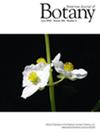Mast years increase wind pollination and reduce seed predation in sugar maple (Acer saccharum)
Abstract
Premise
In general, mast seeding (intermittent and synchronous seed production) increases plant fitness through economies of scale in which reproduction is more successful in high-seed years. These benefits have been most studied in wind-pollinated trees. Increased pollination success in mast years has been considered more important for wind- than animal-pollinated species, although this assumption is rarely explicitly tested.
Methods
In this study, we documented patterns of reproduction in Acer saccharum in central Massachusetts, United States over 15 years. We used pollinator exclusion experiments conducted over 6 years to test whether high-flowering and high-seed years lead to more successful wind pollination, more successful insect pollination, and lower predispersal seed predation. Acer saccharum is both insect- and wind-pollinated, allowing us to compare the strength of these two benefits.
Results
At our study site, A. saccharum was strongly alternate-bearing, meaning that trees alternated synchronously between high-flowering, high-seed years and low-flowering, low-seed years. Wind pollination was higher and predispersal seed predation lower in mast years, but insect pollination was similar in all years.
Conclusions
We showed geographic variation in patterns of A. saccharum seed production in comparison to past research. We also showed that synchronous flowering increases wind pollination more than insect pollination and that it decreases seed predation. Acer saccharum is dichogamous; protogynous trees were more likely to flower in mast years, and protandrous trees experienced larger benefits from wind-pollination in mast years. These results highlight masting trees as interesting study systems for future research on sex allocation.





 求助内容:
求助内容: 应助结果提醒方式:
应助结果提醒方式:


